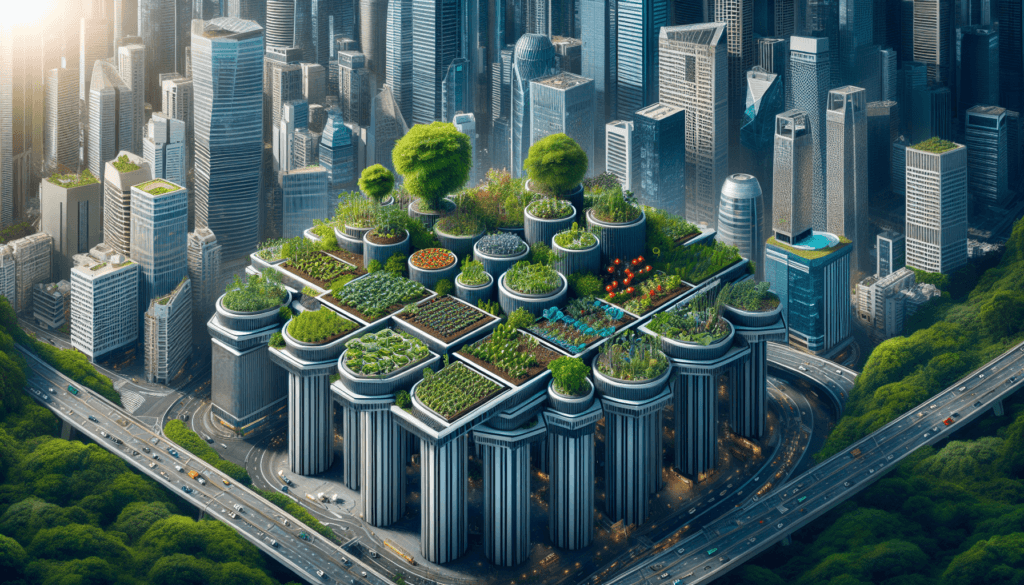Imagine walking through a bustling city with tall buildings and concrete sidewalks, when suddenly you stumble upon a vibrant oasis of greenery. Surrounded by beautifully landscaped gardens, trees, and flowers, this unexpected urban paradise not only adds beauty to the cityscape, but also serves a practical purpose. Welcome to the world of incorporating edible landscaping in urban public spaces. In this article, we will explore the benefits, challenges, and creative ways that cities are embracing this concept to create sustainable and accessible green spaces for everyone to enjoy. From community gardens to rooftop farms, get ready to be inspired by the innovative ways that cities are reimagining urban landscapes.

Benefits of Edible Landscaping
Improving Food Security
Edible landscaping can play a crucial role in improving food security in urban areas. By growing food in public spaces, communities can have easier access to fresh, locally grown produce. This can especially benefit those living in food deserts, where access to fresh and nutritious food is limited. Edible landscaping helps to address food insecurity by providing a sustainable and resilient source of food for communities.
Promoting Sustainable Agriculture
Incorporating edible plants into urban landscapes promotes sustainable agriculture practices. Traditional ornamental plants require regular maintenance and often rely on harmful pesticides and fertilizers. On the other hand, edible plants can be grown organically, reducing the use of synthetic chemicals. Furthermore, edible landscaping encourages the use of compost and natural soil amendments, which improves soil quality and fertility in urban areas.
Enhancing Aesthetics and Community Engagement
Edible landscaping not only provides functional benefits but also helps in beautifying the urban environment. By incorporating edible plants into the landscape, public spaces can transform into vibrant and visually appealing areas. Additionally, edible landscaping attracts the interest of the community and encourages engagement. People feel a sense of ownership and pride when they can enjoy the beauty of the landscape while also having the opportunity to harvest and consume the fruits, vegetables, and herbs grown within their communities.
Selection of Edible Plants
Consideration of Climate and Soil Conditions
When selecting edible plants for urban landscapes, it is crucial to consider the local climate and soil conditions. Different plants have specific requirements in terms of temperature, sunlight, and soil pH. By choosing plants that are well-suited for the local climate, they are more likely to thrive and yield a successful harvest. Additionally, considering the soil conditions is important to ensure that the plants have the necessary nutrients and drainage for healthy growth.
Choosing Suitable Varieties
Urban environments may have limited space and unique growing conditions, such as contaminated soil. Therefore, selecting suitable varieties of edible plants is crucial for successful growth. Certain plant varieties are bred to be resilient to urban conditions, such as compact growth habits that can thrive in containers or plants that can tolerate air pollution. By choosing appropriate plant varieties, the chances of a bountiful harvest are increased, even in challenging urban settings.
Integration with Local Flora
Integrating edible plants with the existing local flora can create a harmonious and ecologically balanced landscape. By selecting companion plants that mutually benefit each other, such as attracting beneficial insects and repelling pests, the overall health and productivity of the edible landscape can be enhanced. This integration can also help to foster biodiversity and support local ecosystems, contributing to the overall sustainability of the urban environment.

Designing an Edible Landscape
Planning Layout and Arrangement
Proper planning of the layout and arrangement is essential for a functional and visually appealing edible landscape. Considerations should be made for the available space, sunlight exposure, and accessibility. Strategically placing taller plants in the northern side of the landscape can provide shade for shorter plants while optimizing sunlight exposure. Creating pathways and grouping similar plants together can help with easier maintenance and harvesting. Proper planning ensures that the edible landscape is not only productive but also aesthetically pleasing.
Creating Multi-functional Spaces
Edible landscaping can create multi-functional spaces that serve a variety of purposes. For example, designing edible hedges along the perimeter of the landscape can provide privacy, noise reduction, and windbreak while also yielding edible fruits. Raised beds or containers can be used to maximize space and allow for easier maintenance. By incorporating seating areas and gathering spaces, the edible landscape can also become a place for community engagement and social interaction.
Incorporating Plant Diversity
Diversity in plant selection is key to a successful edible landscape. By incorporating a variety of fruits, vegetables, and herbs, the landscape not only becomes visually appealing but also helps to avoid the spread of diseases and pests. Diversity also provides a continuous harvest throughout the growing seasons, ensuring a variety of fresh produce is available for the community. Additionally, diverse plantings contribute to soil health through various root structures and nutrient uptake, promoting overall ecosystem resilience.
Implementation and Maintenance
Site Preparation and Soil Amendment
Before implementing an edible landscape, thorough site preparation is necessary. This includes removing any existing vegetation, improving soil quality, and incorporating necessary amendments. Soil tests can determine the nutrient levels and pH of the soil, allowing for appropriate amendments to be made. Adding organic matter, compost, and other soil conditioners can help improve soil structure, moisture retention, and nutrient availability, ensuring optimal conditions for plant growth.
Irrigation and Pest Control
Proper irrigation is crucial for the success of an edible landscape. Urban environments often present challenges such as limited access to water and higher temperatures. Installing efficient irrigation systems, such as drip irrigation or rainwater harvesting systems, can help conserve water and ensure plants receive adequate hydration. Pest control in edible landscapes should focus on organic and integrated pest management methods, minimizing the use of harmful chemicals. Regular monitoring, timely intervention, and encouraging natural predators can help control pests effectively and sustainably.
Regular Harvesting and Pruning
Regular harvesting and pruning are essential for maintaining the health and productivity of an edible landscape. Harvesting at the right time ensures the vegetables and fruits are at their peak flavor and nutritional value. Pruning helps maintain plant size, shape, and overall health. Removing dead or diseased plant parts also prevents the spread of pathogens. Regular maintenance activities like weeding, mulching, and fertilizing should be carried out to promote healthy plant growth and minimize competition from weeds.

Community Involvement and Education
Engaging Local Residents and Organizations
Incorporating edible landscaping in public spaces provides an opportunity to engage local residents and organizations. Community involvement can include volunteering in the maintenance and harvesting of the landscape, fostering a sense of ownership and connection. Building partnerships with local organizations, such as schools, community centers, and food banks, can create collaborative initiatives and amplify the impact of edible landscaping efforts. Engaging residents and organizations in the decision-making process and seeking their input and feedback can ensure the edible landscape meets their needs and preferences.
Organizing Workshops and Events
Workshops and events centered around edible landscaping can educate and empower the community. Organizing workshops on gardening techniques, composting, and cooking using locally grown produce can provide valuable knowledge and skills. Hands-on activities, such as planting and caring for edible plants, can help build confidence and enthusiasm among participants. Community events, such as harvest festivals, can showcase the accomplishments and benefits of edible landscaping while fostering community spirit and pride.
Promoting Food Literacy
Edible landscaping presents an excellent opportunity to promote food literacy within the community. By showcasing the journey of food from seed to plate, individuals can gain a deeper understanding and appreciation for the importance of locally grown and sustainable food. Promoting food literacy includes educating community members about healthy eating habits, the benefits of organic and locally sourced food, and the environmental impact of food choices. By increasing food literacy, individuals are empowered to make informed decisions about their food and contribute to a healthier and more sustainable community.
Public Policy and Regulations
Addressing Land Use and Zoning Issues
Incorporating edible landscaping in urban areas may require addressing land use and zoning regulations. Some areas may have restrictions on the types of plants allowed in public spaces or limitations on the use of space for gardening purposes. Engaging with local authorities and policymakers to advocate for supportive regulations, such as allowing for vegetable gardens in public areas, can remove barriers and facilitate the implementation of edible landscaping initiatives. Encouraging the development of urban agriculture policies can help create a supportive environment for edible landscaping to thrive.
Collaborating with Municipalities and Urban Planners
Collaboration with municipalities and urban planners is crucial for the successful integration of edible landscaping in public spaces. By involving planners in the early stages of design and implementation, potential challenges and opportunities can be identified and addressed. Collaboration can also help secure necessary permissions and permits, as well as access to resources and funding. By working together, municipalities, urban planners, and local communities can create vibrant and sustainable urban landscapes that prioritize food production and community well-being.
Advocating for Supportive Policies
Advocacy plays a vital role in promoting the adoption and expansion of edible landscaping initiatives. By advocating for supportive policies at the local, regional, and national levels, the benefits of edible landscaping can be recognized and integrated into urban planning strategies. This includes advocating for incentives, funding, and grants to support the implementation and maintenance of edible landscapes. Collaborating with other organizations and stakeholders, such as environmental groups and health organizations, can amplify the impact of advocacy efforts and promote systemic change.

Successful Case Studies
City Farms and Community Gardens
City farms and community gardens have demonstrated the success of incorporating edible landscaping in urban public spaces. These initiatives provide opportunities for residents to grow their own food, fostering self-sufficiency and community connections. City farms, which are larger-scale operations, can produce significant quantities of fresh produce for local markets and food banks. Community gardens, on the other hand, offer smaller plots for individuals or groups to grow their own food. Both models contribute to food security, community engagement, and the promotion of sustainable agriculture practices.
Edible Forests and Urban Orchards
Edible forests and urban orchards are innovative approaches to edible landscaping that mimic natural ecosystems. By planting fruit and nut trees, shrubs, and edible perennial plants, urban spaces can transform into abundant food-producing landscapes. These edible forests provide a diverse range of food sources, reduce the need for intensive maintenance, and contribute to overall biodiversity. Urban orchards, which focus on fruit-bearing trees, create a beautiful and productive landscape while promoting community engagement through communal harvesting and educational programs.
Green Roof and Vertical Gardening
Green roofs and vertical gardening utilize underutilized spaces in urban areas for food production. Green roofs, which involve the installation of gardens on the rooftops of buildings, provide multiple benefits, including insulation, stormwater management, and improved air quality. By incorporating edible plants into green roofs, these spaces can also contribute to food production, especially in areas with limited ground space. Vertical gardening, using trellises, walls, or other vertical supports, maximizes space efficiency, adding a vertical dimension to edible landscaping. These approaches are particularly useful in densely populated urban environments where space is a premium.
Economic Viability and Sustainability
Market Potential of Edible Landscaping
Edible landscaping has economic potential beyond its social and environmental benefits. The produce grown in urban edible landscapes can be sold locally, providing an additional income source for individuals or community organizations. Farmers’ markets, farm-to-table initiatives, and local restaurants can become potential customers for the fresh, locally grown produce. By tapping into the market potential of edible landscaping, it becomes more financially sustainable and can support the long-term viability of urban agriculture.
Creating Localized Food Systems
Edible landscaping promotes the creation of localized food systems by reducing dependence on long-distance transportation and large-scale agriculture. By growing food within the community, the need for excessive packaging, refrigeration, and transportation is minimized, reducing the associated carbon footprint. Localized food systems also foster a stronger connection between consumers and producers, promoting transparency and trust. Additionally, by supporting local food production, communities become more resilient and less vulnerable to disruptions in the global food supply chain.
Long-term Benefits and Cost-saving Opportunities
Implementing edible landscaping in urban public spaces brings long-term benefits and cost-saving opportunities. By growing food locally, communities reduce their reliance on expensive store-bought produce. Edible landscapes can also contribute to energy savings through urban cooling effects, stormwater management, and reducing the urban heat island effect. These long-term benefits translate into cost savings for communities and individuals, providing an incentive for the widespread adoption of edible landscaping practices.

Challenges and Potential Solutions
Limited Space and Accessibility
One of the main challenges in incorporating edible landscaping in urban areas is limited space and accessibility. However, with creative design and planning, even small spaces can be utilized effectively for food production. Vertical gardening, container gardening, and rooftop gardens are potential solutions for areas with limited ground space. Additionally, creating accessible pathways and raised beds can ensure that individuals of all abilities can participate in and benefit from edible landscaping initiatives.
Mitigating Environmental Risks
Edible landscaping in urban areas may face environmental risks, such as contaminated soil or air pollution. Conducting soil tests and remediation efforts can address soil contamination issues. Utilizing organic growing practices can help minimize the risk of harmful chemical exposure. Air pollution can be addressed by selecting plants that are known to tolerate high levels of pollution. Monitoring air quality and taking necessary measures, such as planting air-filtering plants or utilizing air purification systems, can help mitigate the environmental risks associated with urban environments.
Addressing Cultural Perceptions
Cultural perceptions and attitudes towards edible landscaping may present challenges to widespread adoption. Some individuals may view edible plants as less aesthetically pleasing compared to traditional ornamental plants. Educating the community about the benefits and aesthetic potential of edible plants can help change these perceptions. Highlighting the beauty of edible plants, such as the vibrant colors and unique shapes of certain fruits and vegetables, can increase acceptance and encourage the incorporation of edible landscaping into urban public spaces.
Future Trends and Innovations
Urban Agriculture Technologies
Advancements in urban agriculture technologies are shaping the future of edible landscaping. Hydroponics, aquaponics, and aeroponics are innovative methods that allow for food production in urban environments without soil. These technologies utilize nutrient-rich water solutions and controlled environments to maximize yields while minimizing resource consumption. Vertical farming and indoor farming techniques also offer the possibility of year-round food production in urban areas. These technological advancements have the potential to revolutionize urban agriculture and make edible landscaping even more accessible and efficient.
Integration of Smart Systems
The integration of smart systems, such as Internet of Things (IoT) and sensor technologies, can enhance the productivity and sustainability of edible landscapes. IoT devices can monitor soil moisture levels, temperature, and plant health, allowing for precise and efficient irrigation and nutrient management. Sensors can provide real-time data on environmental conditions, pests, and diseases, enabling timely intervention and reducing the use of chemicals. Smart systems also facilitate remote monitoring and automation, making it easier to maintain and manage edible landscapes in urban areas.
Collaborative Design and Planning
Collaborative design and planning processes are becoming increasingly important for the successful implementation of edible landscaping in urban public spaces. Engaging with stakeholders, including community members, landscape architects, urban planners, and policymakers, ensures that the design reflects the needs and desires of the community. By involving all relevant parties from the early stages of design, potential challenges can be addressed, and innovative solutions can be developed. Collaborative approaches also foster a sense of ownership and pride among community members, leading to the sustainability and long-term success of edible landscaping initiatives.
Incorporating edible landscaping in urban public spaces presents numerous benefits, from improving food security and promoting sustainable agriculture to enhancing aesthetics and community engagement. Through careful selection of edible plants, proper design and maintenance, community involvement, and favorable public policies, edible landscaping can become an integral part of urban environments. Successful case studies, economic viability, and future trends show the great potential of edible landscaping for creating resilient, sustainable, and vibrant cities.


